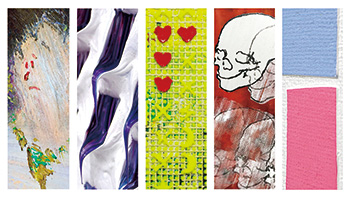
|
KANSAI VOICES - A journey through painting today -2020 12.18 - 2021 2.6Winter holidays |

KANSAI VOICES
- A journey through painting today -
Venue: nca | nichido contemporary art
Date: 2020.12/18 (Fri.)-2021.2/6 (Sat.)
Opening hours: Tue. ~ Sat. 11:00 – 19:00 (Closed on Sunday, Monday and National holidays)
*Winter break: 2020.12/29 ~ 2021.1/11
Artist: Shinya Azuma / Shinya Imanishi / Yoshihiro Takeuchi / Shohei Yamamoto / Hiroaki Yoshioka
*The gallery will be open until 20:00 on the exhibition opening day 12/18 (Fri.)
nca | nichido contemporary art is pleased to present the group show “KANSAI VOICES - A journey through painting today-“.
The expressive language of contemporary art is an ever fast changing reality that travels across fields and continues to assimilate progress in all its forms, from new technologies to scientific achievements, reinventing itself every day.
Painting, too, has seen the emergence of new styles, each representing a mirror of their time while bouncing back and forth between realism and abstraction.
The exhibition introduces the work of five Kansai-based young painters who are currently making a name for themselves.
Artists from the same generation, they have also been developing their practice surrounded by the same environment. Equipped with a specific style and approach, each of these artists has been groping for ways to best express their inner world and reality on the painting surface. So, the question is: how have they accomplished that and come up with their own expressive language? The exhibition presents new works made especially for this occasion.
The exhibition was made possible thanks to the support of Shinya Imanishi, one of the participating artists.
With bold strokes Shinya Azuma (1994-) depicts bits from landscapes and situations he captures on the news or that simply belong to his everyday life. Passers-by and drunkards spotted on the street, saints, the artist himself, many are the characters inhabiting Azuma’s work. Their faces, however, as well as their bodies are simplified to the extent that we can distinguish no expression nor any human-like features. It feels as if the paint, applied in layers as if to cover their faces, is hiding those mixed feelings that are usually well hidden beneath the surface. Azuma, who claims that inside the painting the paint itself as matter becomes equally real, seems to be questioning, beneath the bright, funny, pop and lighthearted surface of his work, the importance of appearance and the social hierarchy that seems to be an ever-present feature in human societies.
Shinya Imanishi (1990 -) creates his paintings through the repetition of a set of actions: first, the artist applies several thick layers of oil paint to the canvas, then, through a vigorous touch, he leaves visible brushstrokes on the painted surface and finally scoops out the paint as he goes. By distancing ourselves from the canvas, images associated with decadence, loss and transformation, yet evoking at the same time ideas of revival and resuscitation, come to the surface: thunders, fireworks, fading lights and candle-flames, Imanishi’s motifs embrace the relationship between death (the end) and life (the beginning) as complementary. The smallest change in our perspective or stance brings to light new visual possibilities that seek to unveil the ambiguity and uncertainty of the things we deem familiar.
Always trying to incorporate the structure of video games into his work, Yoshihiro Takeuchi (1987-) has been focusing his recent production on the puzzle game “Puyo-Puyo”. To win players must gain points by clearing all the pieces (puyos) that keep falling from the top of the screen, group matching colors, shapes, and so forth, next to each other. When the matched puyos disappear, the portion of the screen previously occupied by the pieces becomes empty evoking the image of a blank canvas. Standing in front of Takeuchi’s randomly aligned “objects”, our brain instinctively pictures possible combinations by deleting and adding pieces at will, giving shape to new images each time that, going back and forth between reality and fiction, address the concept of identity, communication and other universal themes.
Drawing inspiration from Buddhist philosophy and Japanese literature, two of his passions, Shohei Yamamoto (1994 -) creates paintings that deal with the broad subject of reality’s very origin and nature.
Expanding on the Buddhist idea that “all phenomena are incomplete, impermanent and do not constitute a fixed entity”, Yamamoto welcomes a process where his continuous applying paint to the surface, combined with the randomness originated by that very physical act, causes the image to become gradually blurred, and, using a paint roller which he made himself, he fabricates repetitions of the same image over and over again. By leaving traces on the surface through a manual approach that challenges copy-paste technology, Yamamoto makes us rethink from scratch the relation between copy/reference and copy/original, and warns us about the phenomenon of information overload that characterizes today’s information society.
Hiroaki Yoshioka (1993 -) focuses on how colors, visual traditions and styles interact on a flat surface and explores the mutual relation between himself and that very interaction. Since 2015, his exhibitions have been focusing on works that simultaneously investigate the tension between physical process and existence, singularity and individuality, original and copy, precision and chaos. Yoshioka believes that it is not necessary for the viewer to understand what lies beneath a work, or what resonates with it from its visual surface as, rather than showing something through a visual language or a certain symbology, his work behaves as if the very material, as an artwork in itself, disrupts the viewer’s identity to propose a reinterpretation of the process through which a work is appreciated.

